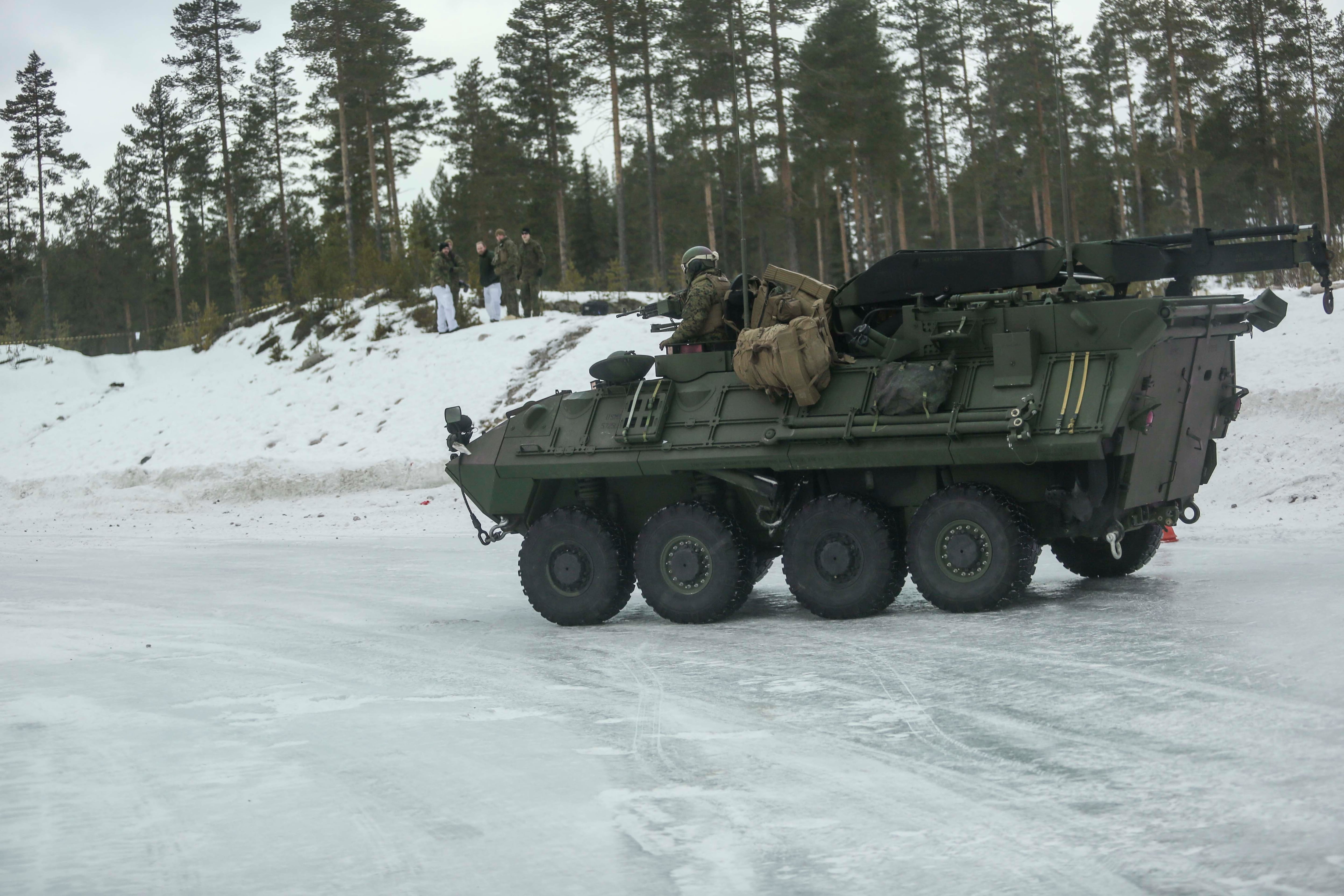Winter is coming, Marines. [[Matt, -- I changed the lede and the hed as we discussed. I know I get after you for newsier ledes, but in this case, I think your suggestion for this lede is perfect. Winning! GH]] Marines kicked off the largest international cold weather training event in decades.
Members of arines from the 2nd Marine Expeditionary Brigade and Marine Corps Forces Europe joined forces with the Norwegian troops and 10 other militaries military and 11 allied and partner nations Tuesday to kick off launch the largest iteration of Exercise main exercise portion of Cold Response ever 2016.
The 10-day main exercise will thrusts about 16,000 troops Marines, 6,500 Norwegians and 4,000 NATO partner troops into grueling, subzero conditions to test their ability to move and fight together against a common enemy adversary.
"It will be more or less a traditional scenario with an aggressor part and a defending part," Brig. Gen. Eldar Berli, commander of the Norwegian army's Brigade North, said in a NATO video. "It is an exercise that we have conducted here in Norway for many, many years." [[Matt, when you can avoid, let's use the interviews you got instead of one from a release up top. Those can be pushed down. GH]]
For the first time, all of the troops participating in Cold Response will form a it also integrates all participating military personnel under one combined joint task force that will be — formed Feb. 22 — led by Norway’s Brigade North.
That combined with the scale of the exercise will help Marines better prepare to operate alongside NATO troops, said Col. William Bentley, 2nd MEB’s operations officer. During past iterations Cold Response, a battalion of Marines or fewer participated, he added. [[Is this graph OK, Matt? Wanted to set up his quote below. GH]]

Cpl. Cody Stoffel, an amphibious assault vehicle crewman with the Bulgaria-based Combined Arms Company, gives firing commands to the gunner during a live-fire exercise in the frozen hills of Rena, Norway.
Photo Credit: Cpl. Dalton Precht/Marine Corps
"Marine Corps participation was [previously] at the battalion level and below with a lot of unit training going on, but I don’t think we’ve had this scale in Norway," Bentley said Col. William Bentley, 2nd MEB’s operations officer. "Zero [degrees] and below is for most of us extreme temperatures, and being able to put all this together and operate over the better part of 60 days start to finish, it’s just an outstanding opportunity for both coalition and NATO interoperability."
The 10th iteration of the annual event, however, is the largest with approximately 16,000 participants.
For the first time, it also integrates all participating military personnel under one combined joint task force — formed Feb. 22 — led by Norway's Brigade North.
"Marine Corps participation was [previously] at the battalion level and below with a lot of unit training going on, but I don't think we've had this scale in Norway," said Col. William Bentley, 2nd MEB's operations officer. "Zero [degrees] and below is for most of us extreme temperatures, and being able to put all this together and operate over the better part of 60 days start to finish, it's just an outstanding opportunity for both coalition and NATO interoperability."
Marines converged on began converging on Norway for the exercise in January to learn to adapt to the frigid climate and conduct live-fire maneuver training in preparation to prepare for the main exercise. They also began unloading gear stashed in Norwegian caves as part of unsealed broke the seal on the Marine Corps Prepositioning Program — Norway to bring its forward-deployed gear to the table.
"This is about being expeditionary ... , getting out of town, falling in on pre-positioned gear and operating in a really hostile cold weather environment," Bentley said.
First opened at the height of the Cold War in 1982 to defend against the Soviet Union, the system of climate-controlled caves stores upward of 6,500 pieces of equipment, including M1A1 Abrams main battle tanks, light armored and amphibious assault vehicles and artillery.
In all, it's enough to sustain a 15,000-person Marine expeditionary brigade for up to a month's combat operations.

Marines with the Bulgaria-based Combined Arms Company put their ice-driving skills to the test in Norway.
Photo Credit: Cpl. Dalton Precht/Marine Corps
With Russia aggressively knocking on NATO’s door — from Norway to the Baltic states to Ukraine and Turkey — Cold Response affords an excellent opportunity for allied troops to operate together and for Marines to keep both MCPP-N’s gear stored in Norway and allied interoperability fine-tuned.
Marine armor moving out for Exercise Cold Response 2016 comes only days after the Pentagon rolled out a substantial increase for the European Reassurance Initiative, its program to shore up European defenses to counter Russia’s provocations.
Requested funding Funding for that program the ERI will rise jumped to $3.4 billion in 2017 from its current budget of $2.6 billion the year prior.
"There are a lot of extremely hard things we've done and lessons we've learned already," Bentley said. "Cold Response is an outstanding opportunity to bring this together and yeah, this is not summer weather."
Troops Military forces from Germany, Sweden, the United Kingdom, Finland, the Netherlands, Poland, Denmark, Canada, Belgium and Latvia are also participating in the cold-weather exercise Cold Response 2016.
"It will be more or less a traditional scenario with an aggressor part and a defending part," Brig. Gen. Eldar Berli, commander of the Norwegian army's brigade north, said in a NATO video. "It is an exercise that we have conducted here in Norway for many, many years."
Matthew L. Schehl covers training and education, recruiting, West Coast Marines, MARSOC, and operations in Europe, Africa and the Middle East for Marine Corps Times. He can be reached at mschehl@marinecorpstimes.com.





